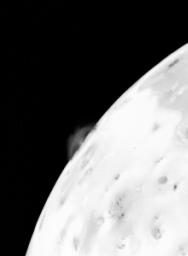Io - One of at Least Four Simultaneous Erupting Volcanic Eruptions
Caption:
This photo of an active volcanic eruption on Jupiter's satellite Io was taken 1 hour, 52 minutes after the accompanying picture, late in the evening of March 4, 1979, Pacific time. On the limb of the satellite can be seen one of at least four simultaneous volcanic eruptions -- the first such activity ever observed on another celestial body. Seen against the limb are plume-like structures rising more than 60 miles (100 kilometers) above the surface. Several eruptions have been identified with volcanic structures on the surface of Io, which have also been identified by Voyager 1's infrared instrument as being abnormally hot -- several hundred degrees warmer than surrounding terrain. The fact that several eruptions appear to be occurring at the same time suggests that Io has the most active surface in the solar system and that volcanism is going on there essentially continuously. Another characteristic of the observed volcanism is that it appears to be extremely explosive, with velocities more than 2,000 miles an hour (at least 1 kilometer per second). That is more violent than terrestrial volcanoes like Etna, Vesuvius or Krakatoa.
Cataloging Keywords:
| Name |
Value |
Additional Values |
| Target |
Io |
|
| System |
Jupiter |
|
| Target Type |
Satellite |
|
| Mission |
Voyager |
|
| Instrument Host |
Cassini Orbiter |
Voyager 1 |
| Host Type |
Orbiter |
Flyby Spacecraft |
| Instrument |
Imaging Science Subsystem (ISS) |
|
| Detector |
|
|
| Extra Keywords |
Grayscale, Infrared, Plume, Volcano |
| Acquisition Date |
|
| Release Date |
1996-11-16 |
| Date in Caption |
1979-03-04 |
|
| Image Credit |
NASA/JPL |
| Source |
photojournal.jpl.nasa.gov/catalog/PIA00374 |
| Identifier |
PIA00374 |

